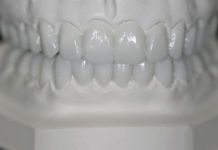
At Arrowhead Dental Laboratory, our passion is helping dentists become better and more productive. We want all dental practices to succeed and thrive. Success isn’t limited to a dollar amount; we want dentists to experience success in their dental practices, success in their clinical skills, success with their practice management skills, and success with their communication and selling techniques. If you’re reading this and want to improve in any of these areas, we can help.
Doctors, are you being asked to compromise by patients or dental insurance companies? Do you justify inferior services or products to make ends meet by saying, “It’s a business decision”? Do you downgrade treatment plans based on a fear that patients may go somewhere else if they’re too expensive? Have you ever put a “W” in a patient’s chart to indicate that you are waiting for the dentistry to break instead of advising the patient on preventative treatment?
If your answer to any of the above questions is yes, then you may be doing a disservice to your patients and ultimately to yourself as a dentist. Soon, you will believe you aren’t the best doctor and it will reflect in all things professionally and otherwise.How do I know this? Because I’ve witnessed it every weekend, when doctors at continuing education (CE) courses with the Dr. Dick Barnes Group (DDBG) share stories about the toll such compromises have taken.
All dentists should analyze their businesses and ask, “Are we really offering the best?” If a dental practice offers care based on the dictates of insurance or to please the patient, it might not be so. I’ve witnessed the consequences of cost-cutting and lower and lower negotiated insurance rates to gain a patient base at the expense of the overall dentistry. I feel it’s time for dentists to take a stand. This is a call for dentists to resist the pressure of insurance- or patient-dictated treatment.
Step One: Practice Comprehensive Care
To avoid the pressure of insurance- or patient-driven care, the first step is to become comprehensive in your approach to dentistry. The result will be that everyone wins. The dentist wins because he or she is using the best materials, seeing the best possibilities, and treating patients with the best recommendations. The patient wins because dentists are not choosing inferior products or subpar treatments. With comprehensive dentistry, the creed is to “always choose the best.”
Comprehensive dentistry is looking beyond the “onesies” and “twosies” and looking comprehensively at the care and wear of a patient’s mouth (see Dr. Jim Downs’s story, “Who’s the Doctor, Doctor?” for more tips on comprehensive care). It’s looking beyond the teeth to what is happening in the muscles, joints, symmetry of the patient’s face, ears, eyes, chin, etc.
Most patients don’t like to be told they need something done each time they visit the dentist. Instead, dentists should discuss a comprehensive treatment plan with every patient to give them a strategy for good oral health throughout their lifetime.
Step Two: Analyze Insurance Agreements
The second step is to review all insurance agreements. Dentists can’t alter already-negotiated insurance rates, but they can re-evaluate their contracts and adjust them when they are up for renewal. Over the years, dental insurance agencies have often systematically cut costs and offered lower rates to dentists. At some point, it isn’t worth it to do business on their terms.
If you feel trapped by a dental insurance contract, read
Dr. Gary Nankin’s story in the Summer 2019 issue of Aesthetic Dentistry magazine (www.adentmag.com). Dr. Nankin explains what to do when considering participation with a PPO-provider and how to ensure that the arrangement is beneficial for the dental practice.
Insurance plans will always have a place in a dental practice—primarily to introduce new patients into the practice. Just as marketing will bring patients into the practice, dentists need to analyze their budgets and margins to make sure insurance participation is an advantageous arrangement.
Usually it’s not advisable to drop all insurance plans and become an entirely fee-for-service practice. Completely eliminating insurance payments can leave gaps in the schedule and misunderstandings with some patients.
However, as a dental provider, never let insurance be the reason that a patient accepts treatment. Instead, pledge to do the best dentistry for the patient regardless of his or her insurance benefits. Let the patient know what the ideal treatment plans are, and always use the best materials. High-quality materials will withstand the test of time, and patients will notice and appreciate it.
Step Three: Know Good Insurance Ratios
To stop being an insurance- or patient-driven practice, it’s important to understand and have a healthy collections ratio of private payments versus insurance payments. Before Tawana Coleman, the retired Total Team Training instructor, would visit any practice for a private consultation, she would review these numbers with them to give her an idea of where the office was in terms of insurance collections.
A good goal to work towards is collections of 80 percent from private payments, and 20 percent from insurance. This is an ideal ratio for a comprehensive dentist. Dentists can increase their production per hour by treating the full mouth.
Step Four: Use the Best Materials
Do you currently know what materials you are putting in your patients’ mouths and where those materials are from? The U.S. Food and Drug Administration (FDA) regulates quality assurance and materials. To find high-quality materials, look for ones that are made in the U.S.A. and are FDA-approved. Yes, it might make costs go up somewhat, but the end result will be worth it. At Arrowhead, it’s a standard that we’re not willing to compromise on.
In my job as Director of Business Development for Arrowhead, I’m the first point of contact when practices inquire about a lab partnership. Many times, a dental assistant initiates the first conversation. When I ask why they are considering our lab, they often candidly say, “I don’t think that what we are using is acceptable. It looks cheap. It doesn’t fit. It’s time we start using something better.”
In our trainings with dental teams, we teach that the first thing to communicate to a new patient inquiring about dental services is the assurance that they’ve called the best provider. If your dental team can’t comfortably tell patients, “You’ve called the best, and in my opinion, you’ve never had a crown as good as this doctor can provide,” you’ve devalued everything to a point that you probably shouldn’t comfortably charge what you do.
I remember conversations with some dentists who said that if their restorations didn’t hold up for the five-year replacement clause, they would remake them with no questions asked. I’m not a dentist, but I’ve been told that replacing a restoration every three to five years may actually weaken the structure of a tooth, and could contribute to the degradation of the tooth faster than a high-quality material or a good-fitting crown. Rather than risk a poor-quality restoration breaking, why not ask patients if they prefer the best material? The answer may surprise you.
Some dentists justify using inferior materials by saying, “Why does it matter what the quality is if the restoration is in the posterior areas of the mouth?” You will always win with the best quality in every area.
My Experience
I’ve had Elite veneers on my teeth for 12 years, and not one has de-bonded, cracked, or needed replacement. I can recommend Elite restorations because I know what they’ve done for me. I’ve witnessed the high-quality materials and skilled craftsmanship that went into my restorations.
Have they lasted longer than what “insurance deems necessary”? Absolutely! Do your products outlast these clauses? If so, that’s a built-in value that patients are willing to pay extra for. How can you have patients pay the extra costs? Your practice may be able to utilize upgrade and rehabilitation fees. If I ever needed another set of veneers, I would gladly pay for a second set of Elites, based on my own experience.
To illustrate the fallacy of compromising on quality, Tawana used the example of a patient needing a heart stent. If the cardiovascular surgeon suggested saving a little bit of money on heart surgery by providing an inferior stent that “mostly” worked, do you think most patients would go for it? Or worse, would the doctor use an inferior product without the patient being aware of better alternatives available? Of course not.
Tips for the Best Dentistry
To offer the best dentistry for your patients, here are my top tips:
- Understand your fee per hour. Do you know how much it costs your practice per hour to keep the doors open and the lights on? If you know how much it costs to run the practice on an hourly basis, you can better determine whether the insurance payout is enough. Don’t get caught in the trap of agreeing to insurance rates to attract new patients if the numbers just don’t add up. You could end up losing money.
- Manage usual, customary, and reasonable (UCR) rates. Is your practice on the low or high end of the range for your area? Some companies offer a practice analysis on UCR rates so you can learn if your fees are high or low for your area. Consider raising fees if you aren’t staying ahead of the curve. If you are operating in the low end of the range, how are you making up the difference? Speed? Hygiene? More crowns per hour? Fillings? Our recommendation is that recare should pay for everyone’s salaries, excluding the doctor’s.
- Make insurance propositions a win-win. Here are some tips on how to be more selective with insurance partnerships.
- Negotiate all fees. Never accept the first plan that insurance companies offer. Many times they will come back with an additional two or three offers at better rates if dentists don’t accept the terms of the first offer.
- Make a schedule and know when insurance contracts are up for renewal. Don’t automatically renew any contracts without reviewing the terms and re-negotiating. If you prefer to outsource this job, there are companies that will negotiate and manage your contracts. Keep in mind that there are fees for outsourcing.
- Analyze all insurance collections and write-offs. Knowing your practice’s numbers will help determine if an insurance plan is worth keeping or not. Be wary of any insurance plan that dictates inferior treatments for your patients. Also, when considering dropping any insurance, allow patients time to adjust to the changes. Most patients will stay loyal to your dental practice if you courtesy bill for reimbursement, but only after you have developed a relationship of trust and dedicated care.
- 4. Participate in CE. To obtain better skills, faster speed, and improved communication, make participating in CE a lifelong quest. The more experience and education you gain, the better you become as a practitioner.
- Consider in-house membership plans. These plans are growing in popularity within the dental community. I offer several samples of plans that dentists can review, and they can easily launch one that’s right for their needs. In addition, you can outsource the management of such plans to third parties. Remember, production isn’t production until services are rendered, so keep services “scheduled for production” in a different ledger and move them as they are completed.
- Use rehabilitation fees and material upgrades. Always consult your legal advisor to make sure you understand the state laws on these contracts, but rehab fees can be a great way for dentists to make up the difference in fees for comprehensive dentistry. Upgrades and warranties can be offered to patients to give them the best dentistry. Feel free to contact me directly for advice, or see Ben Tuinei’s article, “Playing to Win” in the Winter 2019 issue of Aesthetic Dentistry magazine (www.adentmag.com).
If doctors commit to offering the best dentistry, they will make arrangements with insurance companies that will benefit both patients and dentists. If properly evaluated and negotiated, insurance benefits can work to everyone’s advantage—with the best treatments always offered to all patients.
We believe that it’s vital to take a stand and commit to offering only your best dentistry. When you do, you will believe in your work, you will feel more capable at providing solutions for your patients, your team will exude confidence in your skills and services, and that confidence will be apparent in everything you do. There are no shortcuts and no compromises. Just do the best—every day.









